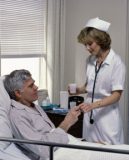
What is a Stroke?
A stroke occurs when the blood supply to the part of the brain is suddenly interrupted (ischemic) or when a blood vessel in the brain bursts, spilling blood into the spaces surrounding the brain cells (hemorrhagic). The symptoms of stroke are easy to spot: sudden numbness or weakness, especially on one side of the body; sudden confusion or trouble speaking or understanding speech; sudden trouble seeing in one or both eyes; sudden trouble walking; dizziness; or loss of balance or coordination. Brain cells die when they no longer receive oxygen and nutrients from the blood or when they are damaged by sudden bleeding into or around the brain. These damaged cells can linger in a compromised state for several hours. With timely treatment, these cells can be saved. Stroke is diagnosed through several techniques: a short neurological examination, blood tests, CT scans, MRI scans, Doppler ultrasound, and arteriography. Stroke seems to run in some families. Family members may have a genetic tendency for stroke or share a lifestyle that contributes to stroke. The most important risk factors for stroke are hypertension, heart disease, diabetes, and cigarette smoking. Other risks include heavy alcohol consumption, high blood cholesterol levels, illicit drug use, and genetic or congenital conditions. Some risk factors for stroke apply only to women. Primary among these are pregnancy, childbirth, and menopause.
Risk Factors for a Stroke:
Stroke prevention is still the best medicine. The most important treatable conditions linked to stroke are:
• High blood pressure. Treat it. Eat a balanced diet, restrict salt intake, maintain a healthy weight, and exercise to reduce blood pressure. In addition, some forms of meditation, controlled breathing exercises and certain dietary supplements have all been shown to have beneficial effects in controlling high blood pressure. Drugs are also available.
• Cigarette smoking. Quit. Medical help is available to help quit.
• Heart disease. Manage it. Your doctor can treat your heart disease and may prescribe medication to help prevent the formation of clots. If you are over 50, you and your doctor should make a decision about aspirin therapy.
• Diabetes. Control it. Treatment can delay complications that increase the risk of stroke.
• Transient ischemic attacks (TIAs). Seek help. TIAs are small strokes that last only for a few minutes or hours. They should never be ignored and can be treated with drugs or surgery.
Symptoms of a Stroke:
If you see or have one or more of these symptoms, don't wait, call 911 right away!
• Sudden numbness or weakness of face, arm, or leg, especially on one side of the body.
• Sudden confusion or trouble speaking or understanding speech.
• Sudden trouble seeing in one or both eyes.
• Sudden trouble walking, dizziness, or loss of balance or coordination.
• Sudden severe headache with no known cause.
Treatment can be more effective if given quickly. Every minute counts!
What are the treatments for stroke?
Generally, there are three treatment stages for stroke: prevention, therapy immediately after stroke, and post-stroke rehabilitation. Therapies to prevent stroke are based on treating an individual's underlying risk factors. Acute stroke therapies try to stop a stroke while it is happening. Post-stroke rehabilitation is to overcome disabilities that result from stroke damage. Medication or drug therapy is the most common treatment for stroke. Surgery can be used to prevent stroke, to treat acute stroke, or to repair vascular damage or malformations in and around the brain. For most stroke patients, physical therapy is the cornerstone of the rehabilitation process. Another type of therapy involving relearning daily activities is occupational therapy (OT). OT also involves exercise and training to help the stroke patient relearn everyday activities such as eating, drinking and swallowing, dressing, bathing, cooking, reading and writing, and toileting. Speech therapy is appropriate for patients who have no deficits in cognition or thinking, but have problems understanding speech or written words, or problems forming speech.
What is the prognosis?
Although stroke is a disease of the brain, it can affect the entire body. Some of the disabilities that can result from stroke include paralysis, cognitive deficits, speech problems, emotional difficulties, daily living problems, and pain.
What research is being done?
Some brain damage that results from stroke may be secondary to the initial death of brain cells caused by the lack of blood flow to the brain tissue. This brain damage is a result of a toxic reaction to the primary damage. Researchers are studying the mechanisms of this toxic reaction and ways to prevent this secondary injury to the brain. Scientists hope to develop neuroprotective agents to prevent this damage. Another area of research involves experiments with vasodilators, medication that expand or dilate blood vessels and thus increase the blood flow to the brain. Basic research has also focused on the genetics of stroke and stroke risk factors. One area of research involving genetics is gene therapy. One promising area of stroke animal research involves hibernation. The dramatic decrease of blood flow to the brain in hibernating animals is extensive enough t that it would kill a non-hibernating animal. If scientists can discover how animals hibernate without experiences brain damage, then maybe they can discover ways to stop the brain damage associated with decreased blood flow in stroke patients. Other studies are looking at the role of hypothermia, or decreased body temperature, on metabolism and neuroprotection. Scientists are working to develop new and better ways to help the brain repair itself and restore important functions to the stroke patients. Some evidence suggests that transcranial magnetic stimulation (TMS), in which a small magnetic current is delivered to an area of the brain, may possibly increase brain plasticity and speed up recover of function after stroke.
The preceding information is courtesy of the National Library of Medicine (NLM).
